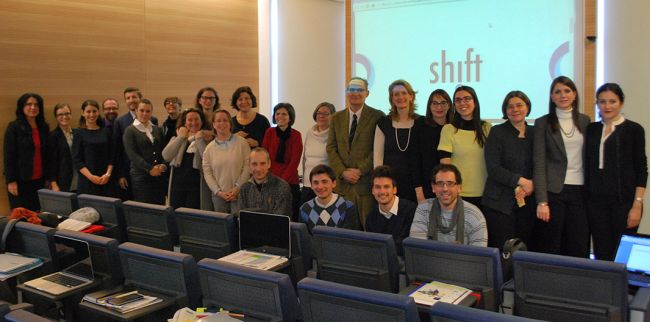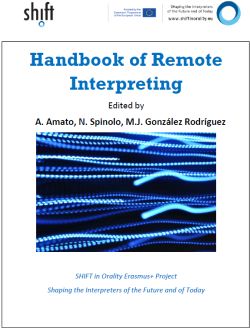
Das mit Mitteln der EU geförderte dreijährige Forschungsprojekt „Shaping the Interpreters of the Future and of Today“ (SHIFT) hat ein 169-seitiges Handbuch zum Thema Ferndolmetschen herausgegeben.
Dieses kann auf der Website der Universität Bologna als PDF-Datei kostenlos heruntergeladen werden.
Im Vorwort heißt es:
 In the last three to four decades the massive diffusion of information and communication technologies has made their price drop dramatically. Access to long-distance real-time audio and video communication which used to be limited to large and wealthy organizations – such as governments or multinationals – has become affordable for a large share of the world population. Advances in ICTs have made it possible to buy products, provide services, or even run a business from portable devices.
In the last three to four decades the massive diffusion of information and communication technologies has made their price drop dramatically. Access to long-distance real-time audio and video communication which used to be limited to large and wealthy organizations – such as governments or multinationals – has become affordable for a large share of the world population. Advances in ICTs have made it possible to buy products, provide services, or even run a business from portable devices.
Until recently, interpreters enabled communication in shared situations
Historically interpreting has been a communication “enabler”, allowing people with different languages and cultures to communicate. But, until recently, interpreters enabled communication in shared situations such as meetings and conferences or in a shared place such as an office, a hospital, a courtroom. As private citizens have increasingly gained access to ICTs, the demand for the provision of distance, fast and immediate services has boomed, and language services are no exception to the rule.
Societies are becoming increasingly multilingual and multicultural
Moreover, since most societies are becoming increasingly multilingual and multicultural, nowadays public and private service providers, companies and institutions have to deal with users/customers who do not necessarily speak their language.
Distance interpreting offers a great opportunity to companies, institutions and organisations to deal with foreign language users/customers efficiently and at a lower cost.
Another advantage offered by distance interpreting is the possibility to recruit interpreters virtually everywhere and for every language. Telephone and videoconference interpreting are therefore rapidly gaining ground in a variety of settings: healthcare, legal, business, administrative.
The European Union recommends distance interpreting even in legal proceedings when language mediation is essential to guarantee the fundamental rights of citizens (Directive 64/2010).
Rapid growth of web-based interpreting platforms
In the field of conference services there is a rapid growth of web-based interpreting platforms allowing interpreters to work from a remote site and participants gathered in a conference room to listen to the interpreter on their mobile phones. Distance interpreting offers some advantages to interpreters too: the possibility to work from home, even from remote locations, and to avoid travelling long distances.
Communicating at a distance differs from face-to-face interaction
But what about the quality and the success of mediated remote communication? Communicating (in a single language) at a distance (via telephone and videoconference) differs from face-to-face interaction in many aspects.
- First of all, there is a lack of social “presence” in remote interactions which makes rapport building more difficult for speakers compared to face-to-face interactions.
- Secondly, the lack of some communication components such as visual, tactile and kinetic can generate communicative “uncertainty” between participants. Some scholars noticed in their studies that speakers in remote interactions tend to rephrase or repeat their utterances because they do not feel sure they have made themselves understood since they have no or only partial access to feedback from other speakers’ gestures or face expression.
- And last but not least there can be difficulties in communication due to poor sound quality.
Interpreters seem to be the most disadvantaged party in a remote interaction
The inherent differences between face-to-face and remote communication mentioned above also apply to distance interpreting and interpreters seem to be the most disadvantaged party in a remote interaction.
- On the phone, they have no access to contextual information or any other input except for what they hear, and in videoconference they only have a partial view of the participants or the setting, and this generates fatigue as the interaction goes on.
- Secondly, it is difficult for speakers who do not see each other or have just a partial view to organize turn taking and this generates for the interpreter and additional need to coordinate turn-taking. The communicative “uncertainty” mentioned above was found to have an impact on interpreters too who tend to “do more” than interpreting to ensure successful communication.
- Another challenge for interpreters is that there is a huge variety of topics that can be at issue in a telephone or videoconference call and it is impossible to predict what the object of the call will be: this means that often interpreters cannot prepare for a specific telephone or video call they have to interpret.
- Finally, poor sound quality is particularly frustrating for interpreters who are supposed to facilitate communication between people who do not share the same language and culture only on the basis of what they can hear. Yet, despite all the shortcomings mentioned above, most studies agree that with well-functioning equipment, good preparation and a high level of experience of interpreters and other participants most of the disadvantages mentioned above can be managed and overcome.
„SHIFT in Orality“ Erasmus+ project aims at developing a comprehensive solution for training in remote interpreting
This is why trainee interpreters and professional interpreters who are willing to start working remotely would benefit from specific training. This is the goal of the SHIFT in Orality Erasmus+ project (www.shiftinorality.eu), whose aim is developing a comprehensive solution for training in remote interpreting in Higher Education and Lifelong Learning through the cooperation of a European network of universities (University of Bologna, University of Granada, University of Surrey, Pablo de Olavide University) offering interpreting programmes and remote interpreting service providers (Dualia SL and VEASYT Srl).
Handbook is part of the teaching materials
 This Handbook is part of the teaching materials developed within the project and has been designed for study and self-directed study. It aims at providing a theoretical framework as well as practical tips to professional interpreters or interpreting students who are willing to start working remotely.
This Handbook is part of the teaching materials developed within the project and has been designed for study and self-directed study. It aims at providing a theoretical framework as well as practical tips to professional interpreters or interpreting students who are willing to start working remotely.
Section 1 of the Handbook presents the theoretical background needed to understand the mechanisms and specific features of remote interpreting (both telephone and videoconference), with a focus on the basic features of remotely interpreted communication, on the importance of linguistic, paralinguistic and kinetic elements, on social, pragmatic and ethical implications, on the settings and subject areas in which remote interpreting is mostly used and on the parties, factors and instrumentalities involved.
Sections 2 and 3 focus on telephone and videoconference interpreting, respectively. They both highlight the difference between face-to-face and telephone/video monolingual interactions and between face-to-face and telephone/video interpreter-mediated interactions. They then present potential problems that may arise in telephone/video interpreted interactions and possible solutions based on examples drawn from a set of research data.
Section 4 summarises the basic requirements and prerequisites for successful communication using remote interpreting. Section 5 illustrates the teaching materials specifically designed for telephone and videoconference interpreting and provides indications about how to use them.
Weiterführende Links
- Handbook of Remote Interpreting herunterladen (Englisch)
- Projekt-Website www.shiftinorality.eu (Englisch, Italienisch, Spanisch)
[Text: Richard Schneider. Quelle: SHIFT, 2018-07-12. Bild: SHIFT.]
